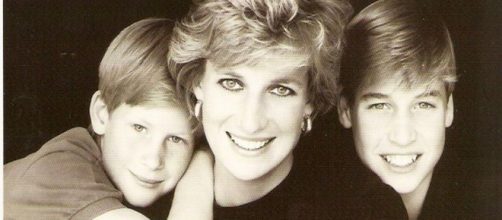British press reviews of the Diana statue, unveiled by her sons in Kensington Park, are brutal. But it’s not clear if the belittling isn’t also meant for her, or the adulation of her.
Double whammy
The Guardian art critic Jonathan Jones jeers that “plays up to mawkish Diana worship.” See what I mean? He’s upset with her popularity.
In a similar way, Simon Heffer, a political commentator at the Telegraph called Diana “the patron saint of a certain type of sentimentality.” There it is again.
What you see
About the sculpture: photographs show a nearly life-size, bronze figure of the late Princess of Wales standing with two little children, a girl on one side and a boy on the other and her hands on their shoulders.
According to the inscription below the statue, the figures are intended as a symbol of Diana’s advocacy for children everywhere. The inscribed message also speaks for her own children: “We remember her love, strength, and character—qualities that made her a force for good around the world…”
It’s personal
Clearly, the statue is personal to William and Harry as is the site. Kensington garden was Diana’s favored place, which is by Kensington Palace, where she lived and where William and his family now live. Picking on the statue as too sentimental is like faulting a child’s Mother’s Day card for being too effusive.
Unaccountable, Jones sees more than the sons’ love for their mother.
He sees “a religious image that “plays up to the most mawkish aspects of Diana worship.” Although conceding that she deserves to be remembered, he questions why she’s transformed into a “colossal divine protector of children” – what he tags a “modern Mary.”
Criteria requirements
Heffer, clearly equally obsessed with Diana’s reputation, narrowly declares the purpose of statues as edifying “greatness” either for accomplishment or sacrifice. As far as he’s concerned, she fits neither criterion. His ideal is the statue of Edith Cavell off of Trafalgar Square. She was a British WWI nurse who saved men in armies on both sides of the war. To hear him tell it if you don’t do something heroic like that, you shouldn’t get a statue.
Wait, he had more ranting to do, contending that the Diana statue is like too much public art in England nowadays – “atrocious.” He points to Maggie Hambling’s commemorative statue of Mary Wollstonecraft, who was a kind of British Gloria Steinem. Inexplicably, the statue pictures this leading feminist without clothes. I agree with him on this one.
Still blustering, Heffner went on to say that the Diana statue reminds him of the “gushing effigies of the Blessed Virgin Mary and Baby Jesus found in the more underfunded southern European basilicas.” He ended, finally, asking why Diana warranted such a “garish Madame Tussaud’s-like effigy.”
I have no intention to pile on here. The Diana statue is plainly her sons’ private tribute shared with the public. If I’m disappointed at all, it would be that the children in the statue aren’t William and Harry given that they not only commissioned the work but also collaborated on it with the artist.


